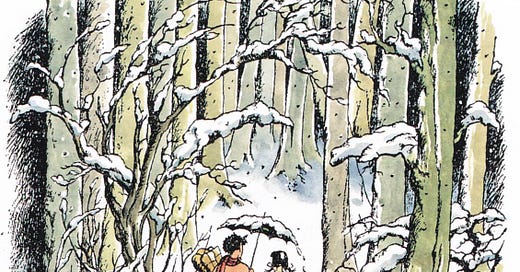Each week, we’ll look behind the scenes—what real world events in Lewis’ life are relevant to this chapter—and dig into the story itself—how can we apply the truths we’ve read.
Inspiration for “What Lucy Found There”
“What Lucy Found There” may be one of the best written chapters in the Narnia series, especially as you think about it reading a chapter a day to small children. It could work as a self-contained short story that builds tensions through foreshadowing within itself, but chapter two also prepares the reader for the conclusion of the book and even introduces ideas Lewis will pick up on in later Narnia books.
Pay attention to how Tumnus is asking questions to confirm that Lucy is a human, but then seems troubled with that realization.
“I’ve never seen a Son of Adam or a Daughter of Eve before. I am delighted. That is to say—” and then it stopped as if it had been going to say something it had not intended but had remembered in time.
This puts the reader on edge and causes us to be worried for Lucy “walking arm in arm with this strange creature as if they had known one another all their lives.” The tension steadily builds throughout the chapter as both Lucy and the reader slowly realize Tumnus’ plan of kidnapping Lucy and turning her over to the White Witch.
But this chapter also paves the way for the rest of this book and even more events to come. In Tumnus’ stories of old Narnia, we hear about the “milk-white stag who could give you wishes if you caught him” that anticipates the adventure that leads the children out of Narnia and back into our world at the end of The Lion, the Witch and the Wardrobe. During his confession, Tumnus even gives us the first mention of the prophecy surrounding “the four thrones at Cair Paravel.”
And, despite Lewis saying he didn’t plan out the series, it’s clear that he drew upon certain ideas and concepts introduced in this chapter to expand in later books. Tumnus talks about midnight dances with the trees and Silenus and Bacchus appearing, both of which Lucy experiences in Prince Caspian. The faun mentions “deep mines and caverns far beneath the forest floor,” which play a pivotal role in The Silver Chair.
Yet, with all that we can appreciate from this chapter, this may be where J.R.R. Tolkien’s dislike of Narnia became cemented. In a 1974 article, Roger Lancelyn Green, a friend of both Tolkien and Lewis, recalls Lewis saying that Tolkien specifically did not like the first two chapters. But why?
Keep reading with a 7-day free trial
Subscribe to The Wardrobe Door to keep reading this post and get 7 days of free access to the full post archives.





